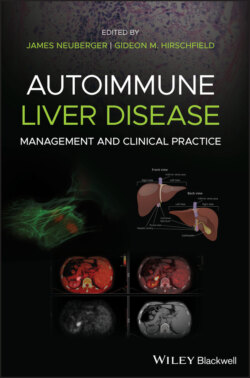Читать книгу Autoimmune Liver Disease - Группа авторов - Страница 17
Liver Cell Types and Organization
ОглавлениеLiver cells can be classified into the following groups:
parenchymal cells, which include hepatocytes and biliary epithelial cells (BECs);
sinusoidal cells, which include hepatic sinusoidal endothelial cells and Kupffer cells; and
perisinusoidal cells, which include the hepatic stellate cells (HSCs) and the pit cells [1].
The hepatocytes, which comprise approximately 60% of the liver cell mass, are epithelial cells with two distinct domains on their plasma membrane: (i) the sinusoidal (or basolateral) surface, facing the sinusoids, in contact with plasma through the fenestrated endothelium of the sinusoids, which allows a bidirectional flow of liquids and solutes though the space of Disse; and (ii) the canalicular (or apical) surface, which encloses the bile ductules and represents the beginning of the biliary drainage system.
The BECs (or cholangiocytes) are the epithelial cells lining the biliary tree. The biliary epithelium shows a morphologic heterogeneity that is associated with a variety of functions performed at the different levels of the biliary tree. Other than funneling bile into the intestine, BECs are actively involved in bile production by performing both absorptive and secretory functions via various membrane transport mechanisms including channels (e.g. water channels and chloride channels), transporters (e.g. ileal BA transporter), and exchangers (e.g. Cl−/HCO3− or Na+/H+ exchangers). The large cholangiocytes are located at the level of interlobular and major bile ducts and they express several different ion channels and transporters at the basolateral or apical domain; they are believed to be mostly involved in secretin/cyclic AMP‐regulated bile secretion. Smaller bile duct branches include terminal cholangioles and ductules or canals of Hering; the latter is a channel located at the ductular–hepatocellular junction, lined partly by hepatocytes and partly by cholangiocytes, and represents the physiologic link between the biliary tree and the hepatocyte canalicular system extended within the lobule. Their secretory function is believed to be mostly regulated by intracellular calcium. More recently, other important biological properties restricted to cholangiocytes lining the smaller bile ducts have been reported, especially with regard to their plasticity (the ability to undergo limited phenotypic changes), reactivity (the ability to participate in the inflammatory reaction to liver damage), and ability to behave as liver progenitor cells.
The hepatic sinusoidal endothelial cells (HSECs) represent 20% of the total liver cells. Unlike capillary endothelial cells, HSECs do not form intracellular junctions and simply overlap one another. They can secrete prostaglandins and cytokines [2]. They are also responsible for maintaining a cell niche that favors the quiescence of HSCs.
The Kupffer cells are specialized tissue macrophages and account for up to 90% of the total population of fixed macrophages in the body. These are macrophages attached to the endothelial lining of the sinusoid, in greater numbers in the periportal areas. They are responsible for removing old and damaged blood cells or cellular debris, bacteria, viruses, parasites, and tumor cells.
The HSCs, also known as Ito cells or lipocytes, are mesenchymal cells and represent the major storage site of retinoids in healthy livers. They lie within the subendothelial space, and their long cytoplasmic extensions have close contact with parenchymal cells and sinusoids, where they may regulate blood flow and hence influence portal hypertension. HSC activation is the central event in hepatic fibrosis. During hepatocyte injury, HSCs proliferate, migrate to zone three of the acinus, change to a myofibroblast‐like phenotype, and produce collagen and laminin.
Finally, the pit cells represent the natural killer (NK) cells of the liver and are located within the sinusoids. Pit cells show spontaneous cytotoxicity against tumor‐ and virus‐infected hepatocytes.
